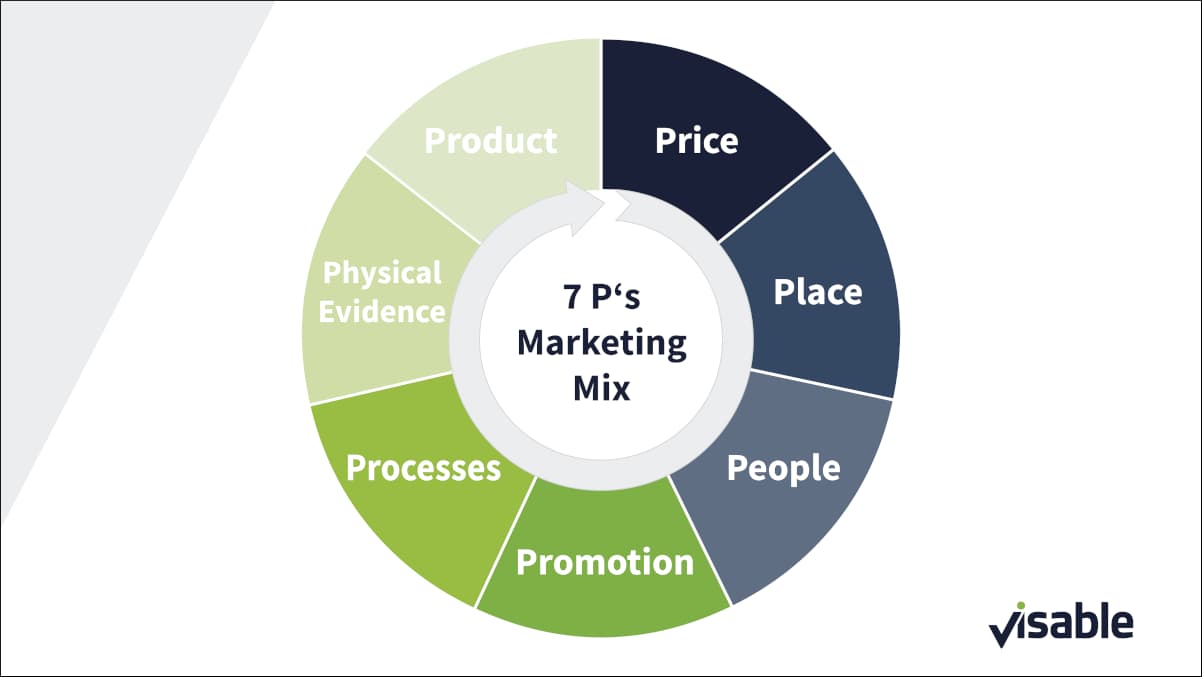The marketing mix is a classic standard in operative marketing. It describes the bundle of all defined measures which aim to achieve the desired marketing objectives. For many years, the marketing mix consisted of the 4 Ps: product, price, place and promotion. However, the 4 P concept can only be applied to the service sector to a limited extent. This is why marketing experts have developed the 7 P concept. Read more about the 7 Ps in marketing here.
These are the 7 Ps in marketing
Product
The first P stands for product and everything that goes along with it. This includes the design of the product and its use for customers, as well as all the services surrounding the product. At the centre of this is deciding which products or services a company wants to offer and how these should be marketed. Important to taking such decisions is comprehensive market research or being close to the target group. These help to determine the relevance of the product or service to the customer.
Increase your visibility to your target audience and showcase your product offering online by creating a free profile on wlw.
Price
Number two of the 7 Ps in marketing centres on finding the right price for the product or service. This covers all external factors such as cost and competition, as well as all additional tasks which have to do with the price. These include delivery and payment conditions, discounts, special deals and warranties.
As a rule of thumb when it comes to determining the price: it should match the products’ quality and all efforts involved in its production. In other words, a product requiring elaborate production and high costs should also be more expensive.

Place
The third P affects all decisions and measures centred round the distribution of the product or service. This not only has to do with the logistics, such as transport and warehousing, but also about aspects of acquisition such as the use of a delivery service. Moreover, important questions need to be clarified: Where will the product be sold? Which partners are suitable for logistics? What about the needs and the shopping habits of the target group?
Promotion
This P is about passing on information about the product or service and winning over customers for the long run. How can you generate attention to the product or service? How can consumers be animated to purchase? This not only covers catchy advertising slogans and attractive designs, but also the promotion of sales in general, measures such as deals and prize draws.
The communication targets consumers and employees, and also includes internal communication between the management and employees. The aim here is to define the company’s image and communicate it as genuinely as possible.
People
The fifth P in the marketing mix stands for people. Like the two areas of measures to follow below, this measure is particularly important in the service sector. Consumers find it difficult to evaluate services, as these are immaterial. Which is why they look for indicators which give an idea of the quality of the service. A high quality of staff in the service sector is such an important indicator.
Therefore, when it comes to the service sector, the name of the game is finding excellent personnel and leveraging them efficiently. The reason why people are one of the marketing tools is because they are the ones frequently providing the service and the satisfaction of customers depends first and foremost on these people.
Process
When it comes to process management, it is not only about just the technical processes, such as the manufacturing of a product. A very important factor is making the service an experience. For this reason, the business process has to be designed to be customer-centric and make the usage by the customer as comfortable and convenient as possible.

Physical Evidence
The final and 7th P in the marketing mix is physical evidence, concerning the optimisation of the physical environment of a product or service. Especially within the service sector, the equipment plays a leading role – after all, here is where the perception of a service cannot be so easily influenced compared to a product, for instance, which can have a high-quality design or elegant haptics.
When it comes to physical evidence, it is about finding the right objects for the company’s objectives that enable the visible environment of a service to positively influence the subjective awareness of the customer. The main tools for this are design, architecture, appearance, equipment and furnishings. These also allow a company to stand out from the competition. Many service providers offer similar services, yet are different from one another in terms of their ambience.
Conclusion
The 7 Ps in marketing are particularly relevant for companies in the service sector. However, not all measures carry the same importance when it comes to addressing the desired target group. A first step for SMEs is market research. This enables them to discover which criteria are most important for potential customers and which areas need to have USPs.
Increase your visibility to your target audience and showcase your product offering online by creating a free profile on wlw.
